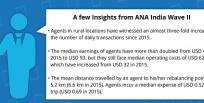
This is the third blog in a three part series, which compares digital financial service offerings in Kenya. The first blog focused on mobile money services, the second one analysed digital credit and this one analyses digital deposits.
Digital deposit accounts are a controversial topic in digital finance. Many analysts note that mobile money providers cannot offer interest on the balance held in a mobile wallet, and that could be a deterrent to greater usage. However, for many Kenyan adults, savings rates are not high enough to make this a salient issue.
Deposit rates in Kenya are consistently below inflation rates, which were 6.9% in 2014, meaning they do not make money for the depositors; they simply help the depositors lose less than if they kept their money in cash or a mobile wallet. That is not the most alluring of value propositions, and the earnings on small account balances of a few hundred shillings (a few dollars) do not add up to much. Looking at deposit rates, M-Benki and M-Shwari provide the best returns, but it is really other features like reliability, flexibility, ease of access and the fact that savings contribute to credit scores that mass market customers generally value most highly.
.jpg)
The most interesting deposit account attributes are not their interest rates but the features they offer that really help people to manage their money. The attached credit features (analysed in the last blog) certainly drive usage, and some products also offer associated insurance cover. M-Shwari and the KCB M-PESA Account also launched a “Lock” feature (fixed deposits).
Furthermore, the KCB M-PESA Account launched an option to save for a specific target, which Equitel now offers as well. Equitel offers the additional feature of being able to send money to future dates. While we do not have usage figures for these different features, these are the factors we expect to differentiate the market most. Given the complexity of the financial management techniques required by mass market customers, we expect these features will go through many changes before they are actively used by the majority of people.
The low minimum balances all products share are excellent, and the absence of maximum account limits for M-Shwari and Equitel are sure to be popular with salaried workers and businesses. However, the maximum limit of one million KSH (US$ 10,000) in the KCB M-PESA Account is probably high enough for most Kenyans. The lower ceilings for Equity HapoHapo and the KCB M-Benki account might limit usage for middle class customers, although it is possible for customers to increase transaction limits by upgrading their accounts. This requires additional KYC details to be provided to the respective banks.
While we do observe some salient differences in terms of deposit rates and maximum limits for digital deposit accounts, we expect usage to be mainly driven by the allure of the credit products that are attached to such accounts. As other money management features are developed, we expect those will further determine successful uptake. Providers that are closely studying the financial management habits of mass market customers; pushing innovation to provide those customers with targeted services; and investing in the streamlined roll-out of those services, will be the winners in this industry.
For now, in terms of digital banking the KCB M-PESA Account seems to be the one to beat, but it is still new and we still need to see that customers will pay their money back.
Each day the battle for market share begins anew. The Kenyan market is certainly complicated at the moment. Providers are pushing the frontiers of mobile based financial services, and it will be very interesting to see who is left behind as the industry steams ahead.
Note: These prices were collected in November 2015 by reviewing provider websites and advertisements; by reviewing terms and conditions; and by calling customer service centres when necessary. It is important to note that volatile market interest rates and dynamic competitive pricing schemes mean that prices change constantly. Further, in multiple cases we received conflicting information from providers on their pricing schemes, and did our best to resolve them.











